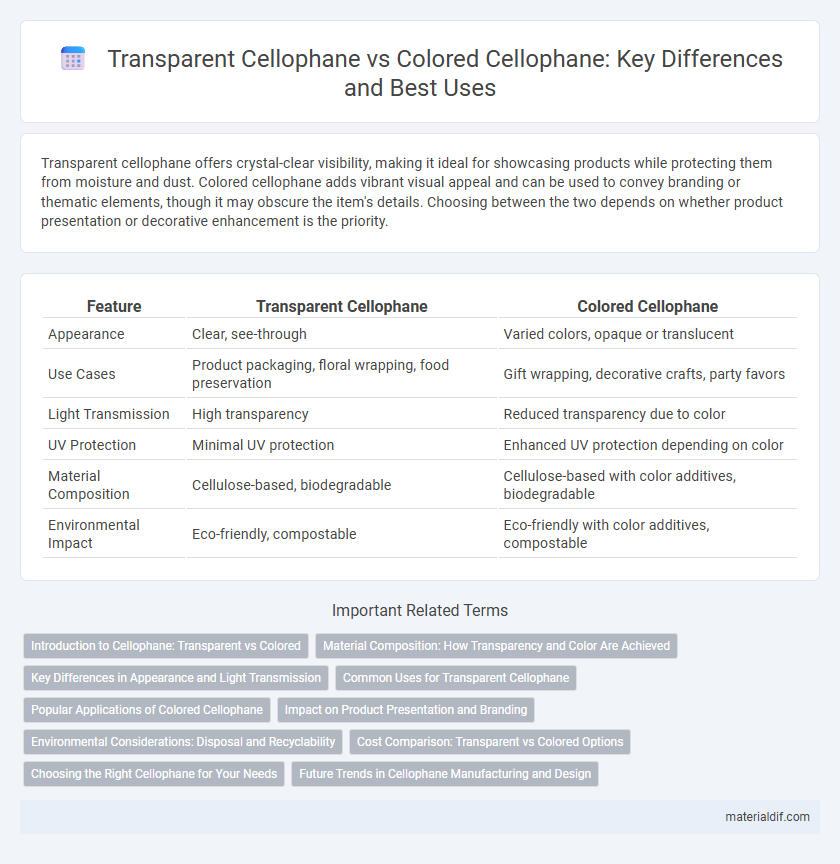Transparent cellophane offers crystal-clear visibility, making it ideal for showcasing products while protecting them from moisture and dust. Colored cellophane adds vibrant visual appeal and can be used to convey branding or thematic elements, though it may obscure the item's details. Choosing between the two depends on whether product presentation or decorative enhancement is the priority.
Table of Comparison
| Feature | Transparent Cellophane | Colored Cellophane |
|---|---|---|
| Appearance | Clear, see-through | Varied colors, opaque or translucent |
| Use Cases | Product packaging, floral wrapping, food preservation | Gift wrapping, decorative crafts, party favors |
| Light Transmission | High transparency | Reduced transparency due to color |
| UV Protection | Minimal UV protection | Enhanced UV protection depending on color |
| Material Composition | Cellulose-based, biodegradable | Cellulose-based with color additives, biodegradable |
| Environmental Impact | Eco-friendly, compostable | Eco-friendly with color additives, compostable |
Introduction to Cellophane: Transparent vs Colored
Transparent cellophane offers clear visibility of packaged products, enhancing their appeal by showcasing contents without obstruction. Colored cellophane adds vibrant hues that provide aesthetic creativity and can be used for branding, identification, or seasonal themes while still maintaining moisture resistance. Both types retain the natural biodegradability and breathability of cellophane, making them eco-friendly choices in packaging.
Material Composition: How Transparency and Color Are Achieved
Transparent cellophane is made from regenerated cellulose treated to maintain clarity by minimizing dyes or pigments during production, allowing high light transmission for clear visibility. Colored cellophane achieves its hues by incorporating water-soluble dyes or pigments into the cellulose solution before film formation, which absorbs certain wavelengths and reflects others, resulting in vibrant color effects without sacrificing flexibility. Both types rely on controlled chemical modifications and additives in the cellulose matrix to balance transparency, color intensity, and mechanical properties for various packaging and decorative uses.
Key Differences in Appearance and Light Transmission
Transparent cellophane offers high clarity and allows maximum light transmission, making objects wrapped inside clearly visible with true colors. Colored cellophane, on the other hand, diffuses light and alters the color perception of the wrapped items due to its tinted appearance, reducing transparency. The main difference lies in their visual impact: transparent cellophane highlights details and natural hues, while colored cellophane enhances aesthetic appeal with vibrant tones but limits see-through quality.
Common Uses for Transparent Cellophane
Transparent cellophane is widely used for packaging fresh flowers, food products, and gift wrapping due to its clarity, which allows the contents to be fully visible while providing moisture protection. This type of cellophane is also favored in retail for creating attractive displays that highlight product features without obscuring details. Its biodegradable nature makes it an eco-friendly choice for packaging in comparison to plastic alternatives.
Popular Applications of Colored Cellophane
Colored cellophane enhances visual appeal and is widely used in gift wrapping, party decorations, and floral arrangements to create vibrant, eye-catching displays. Its versatility extends to packaging for confectionery and promotional items, where bright hues attract consumer attention and convey thematic messaging. The film's ability to filter light while maintaining transparency supports creative uses in crafts and event design, driving its popularity in various artistic and commercial contexts.
Impact on Product Presentation and Branding
Transparent cellophane enhances product presentation by showcasing the item's natural colors and details, creating a sense of purity and freshness that appeals to consumers seeking authenticity. Colored cellophane adds vibrant visual interest and reinforces brand identity through specific hues, making products stand out on shelves and eliciting emotional responses aligned with brand messaging. Choosing between transparent and colored cellophane directly impacts consumer perception, influencing purchase decisions and strengthening brand recognition in competitive markets.
Environmental Considerations: Disposal and Recyclability
Transparent cellophane is typically more environmentally friendly due to its biodegradability and easier recyclability compared to colored cellophane, which often contains dyes and additives that hinder decomposition and recycling processes. Colored cellophane can release harmful chemicals during disposal, complicating waste management and increasing environmental impact. Choosing transparent cellophane supports sustainable packaging efforts by reducing pollution and promoting efficient resource recovery.
Cost Comparison: Transparent vs Colored Options
Transparent cellophane typically costs less than colored cellophane due to simpler manufacturing processes and lower material usage. Colored cellophane involves additional dyes and treatments, increasing production expenses and retail prices. Businesses seeking budget-friendly packaging often prefer transparent options to balance cost with visual appeal.
Choosing the Right Cellophane for Your Needs
Transparent cellophane offers clear visibility, making it ideal for showcasing products or gifts while providing a protective barrier against dust and moisture. Colored cellophane enhances visual appeal with vibrant hues, suitable for decorative packaging or thematic presentations, but may obscure the contents slightly. Selecting the right cellophane depends on whether clarity or aesthetic impact is the priority, balancing functionality with design preferences.
Future Trends in Cellophane Manufacturing and Design
Transparent cellophane remains favored for its clarity and eco-friendly biodegradability, ideal for sustainable packaging solutions. Colored cellophane is gaining momentum due to advancements in pigment integration and UV protection, enhancing aesthetic appeal and product differentiation. Emerging trends emphasize biodegradable polymers and smart materials, positioning both transparent and colored cellophane to meet evolving environmental regulations and consumer demands.
Transparent Cellophane vs Colored Cellophane Infographic

 materialdif.com
materialdif.com